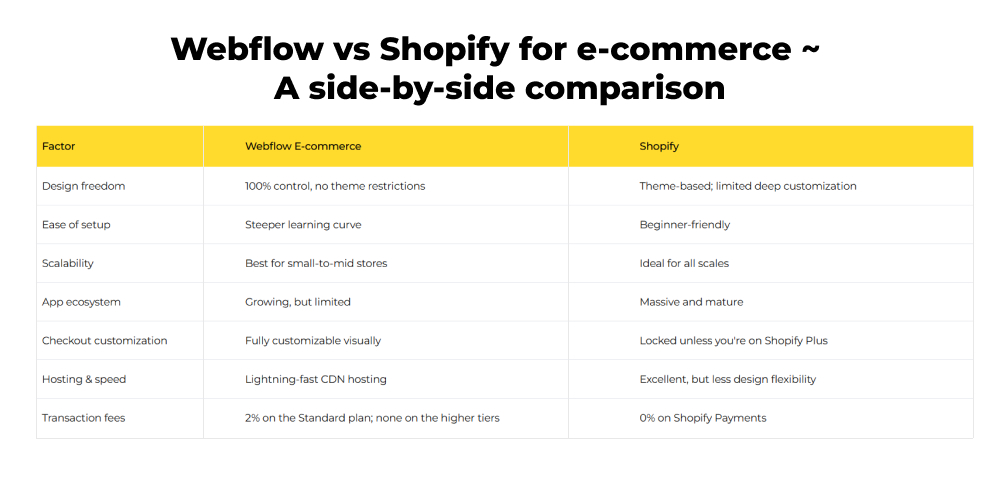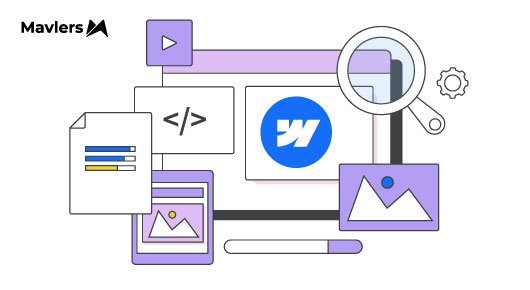Honestly, and we think you will agree, that you can tell a lot about a brand by how its checkout feels.
Is it clinical and quick, like a no-nonsense supermarket?
Is it warm and editorial, like a cozy catalogue that smells faintly of rosemary?
Or does it feel like someone slammed a pop-up and a thousand buttons together and hoped for the best?
That’s the weird, tiny truth; choosing an e-commerce platform isn’t only about features and price. It’s about the story your store tells, the micro-interactions, the page transitions, and the moment a customer clicks “Buy now” and thinks, “Yes, this feels like me.”
If you’re reading this, you’ve probably been eyeing Webflow for e-commerce. Maybe someone on your design team loves it. Maybe you swear by Shopify. Maybe you’re tired of cookie-cutter templates and want control without the plugin chaos of WordPress.
Here’s an honest, unbiased answer: Webflow can be the perfect home for certain stores, if your priorities match what it actually does well.
Below, with our extensive experience and expertise in this CMS, we will guide you through what Webflow e-commerce really offers, its limitations, and how to determine if it’s the right tool for your business.
Let’s begin with decoding what Webflow actually is
So, Webflow can be best described as a visual development platform that gives you the creative freedom to design and build your website, including your store, exactly as you imagined it.
Unlike traditional builders, you’re not stuck with rigid templates or limited theme controls. You drag, drop, and tweak every detail of your layout visually, but underneath, Webflow writes clean HTML, CSS, and JavaScript.
When you choose to add Webflow’s e-commerce functionality, you can do the following:
- Sell products and manage inventory
- Customize your cart and checkout pages
- Process payments through Stripe or PayPal (plus Apple Pay and Google Pay through Stripe)
- Manage orders from your dashboard
- Host your site on Webflow’s secure, lightning-fast infrastructure
If we were to extend the analogy, Webflow gives you the power of a designer, the structure of a CMS, and the tools of an online store, all in one pretty package. But (and this is key) it’s not trying to be Amazon. It’s built for brands that care as much about aesthetics and storytelling as they do about sales.
Understanding the reasons why brands are enamored with Webflow e-commerce
If you’ve ever contemplated a Shopify theme and thought, “Wouldn’t it be so cool if this button just moved like, 10 pixels to the left?” Webflow can come across as a breath of fresh air and a therapeutic experience.
Let’s now explore the benefits of Webflow e-commerce:
1. Design freedom sans compromise
Every pixel is yours to breathe life into and mould as you desire. Straight from the hero banner to the micro-interaction when a user hovers over “Add to Cart,” you get to set the experience. That’s huge for brands built around visual identity, such as fashion labels, boutique candle stores, or lifestyle products that rely on vibe as much as value.
2. No plugin chaos
Webflow is an all-in-one platform that includes design, CMS, hosting, and e-commerce under one roof. You won’t spend half your day updating plugins or troubleshooting a checkout that broke because of a theme update. Fewer moving parts equals fewer migraines. Plain & simple.
3. Fast, secure hosting
Powered by AWS and Fastly CDN, your pages load quickly worldwide, which, let’s be honest, is a huge turn-on for shoppers and thereby directly impacts conversion rates. Nobody likes a slow checkout, not you, and definitely not me!
4. Webflow payment integration simplified
Setting up payments is no longer gonna be a game of jumping through hoops while juggling plates. Stripe and PayPal handle most currencies, cards, and digital wallets securely. For many businesses, that’s all you need.
5. Seamless order management
From the Webflow dashboard, you can manage orders, track fulfillment, and send notifications. It’s surely not an enterprise-grade ERP, but it gets the job done for most small to medium-sized brands.
Simply said, Webflow lets you craft experiences, not just product pages. It’s the difference between building a store and building a brand moment.
Okay, but what about the limits?
We don’t live in utopia, my friend, and everything carries a fine print! Webflow for e-commerce is not different.
You need to factor in the following shortcomings to make an informed, well-thought-out decision;
1. Catalog size
Webflow plans come with item limits, currently 500 (Standard), 5,000 (Plus), and 15,000 (Advanced). If you’re running a huge marketplace or selling thousands of SKUs, this can feel tight.
2. Webflow e-commerce pricing
The Standard plan incurs a 2% Webflow transaction fee (in addition to Stripe/PayPal’s standard fees). Higher tiers waive Webflow’s fee, but you’ll pay more monthly. So, if you’re a high-volume seller, calculate your break-even point before you commit.
3. Limited integrations
Unlike Shopify’s ginormous app ecosystem, Webflow’s marketplace may seem smaller in comparison. Although you can choose to connect tools via Zapier, Make, or APIs, you may need to invest in a developer for complex setups, such as CRM syncs or advanced analytics.
4. Multi-lingual localization
Honestly, Webflow is yet to offer native multi-language support. To compensate for this, you’ll need to utilize tools like Weglot for international stores.
It works fine, but it’s one more integration to manage, so you’ve got to choose your battles/integrations.
In all honesty, while Webflow for e-commerce might fit like a glove for the right business, it may feel like a total misfit for others!
To invest or not to invest?
To help you get off the fence and know for sure if Webflow for e-commerce might be the lost glass slipper to your proverbial Cinderella’s pair, you need to know the exact consumer profiles that it’s truly meant for!
So, it can be the perfect fit for;
Design-driven brands that want to break out of the cookie-cutter Shopify mold.
Boutique retailers with curated products and storytelling-heavy landing pages.
Agencies or creators building unique, branded stores for clients.
Subscription-based businesses (yes, Webflow supports recurring payments now).
To call a spade a spade, if your business thrives on creative control and brand expression and you’re not dealing with thousands of SKUs or enterprise integrations, you’ll love it here.
Here’s a ready reference, quick gut check for you to choose and choose right!
- If your product story sells the product, Webflow will empower you.
- If your operations and integrations effectively sell the product, Shopify or a headless setup might be a better option.
- If you plan to expand internationally soon, factor in localization tools.
Ultimately, the best e-commerce platform is the one that suits your workflow, not the one with the longest feature list.
Tada! There we said it! 😉
Webflow vs Shopify for e-commerce ~ The friendly showdown begins!
We’d bet our last dollar on this, you probably googled this or typed it in Gemini or ChatGPT ~ “Webflow vs Shopify for e-commerce, which is a better choice for my business?”
So, here’s the balanced, no-nonsense, ready reference version;

The road ahead
In case you’d like to dig deeper and find out if Webflow can be a good fit CMS for your business (not just e-commerce), you might want to explore ~ The ultimate Webflow guide ~ How to know if it’s the right-fit CMS for you?


Pratik Bhatt - Subject Matter Expert (SME)
Pratik Bhatt is a web technology and operations manager focused on delivering front-end solutions that support strategic marketing goals. He specializes in crafting user-centric digital experiences and managing projects with clarity and precision. With strong expertise in CMS platforms and digital asset development, he ensures each initiative is scalable, efficient, and impactful, enhancing user engagement while aligning with broader business objectives.
Naina Sandhir - Content Writer
A content writer at Mavlers, Naina pens quirky, inimitable, and damn relatable content after an in-depth and critical dissection of the topic in question. When not hiking across the Himalayas, she can be found buried in a book with spectacles dangling off her nose!
BFCM send game: What Klaviyo’s Black Friday data reveals about peak engagement hours
Offline Support, Push Notifications & Better UX— Courtesy of Shopify PWAs